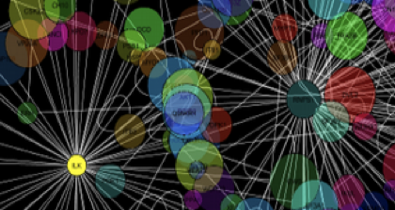SUNDAY FEBRUARY 12, 2006
SIMULATIONS OF HIV INFECTION

This is a joint work with G. Cesareni, A. Ferranti, C. Gavrila, M. Tinti (Department of Biology, University of Rome Tor Vergata, Rome, Italy) and M. Bernaschi (IAC - CNR, Rome, Italy).
Protein interactions support cell organization and mediate its response to any specific stimulus. Recent technological advances have produced large data-sets that aim at describing the cell interactome. These data are usually presented as graphs where proteins (nodes) are linked by edges to their experimentally determined partners. This representation reveals that protein-protein interaction (PPI) networks, like other kinds of complex networks, are not randomly organized and display properties that are typical of "hierarchical" networks, combining modularity and local clustering to scale free topology. However informative, this representation is static and provides no clue about the dynamic nature of protein interactions inside the cell.
To fill this methodological gap, we designed and implemented a computer model that captures the discrete and stochastic nature of protein interactions. In ProtNet, our simplified model, the intracellular space is mapped onto either a two-dimensional or a three-dimensional lattice with each lattice site having a linear size (5 nm) comparable to the diameter of an average globular protein. The protein filled lattice has an occupancy (e.g. 20%) compatible with the estimated crowding of proteins in the cell cytoplasm. Proteins or protein complexes are free to translate and rotate on the lattice that represents a sort of naïve unstructured cell (devoid of compartments). At each time step, molecular entities (proteins or complexes) that happen to be in neighboring cells may interact and form larger complexes or dissociate depending on the interaction rules defined in an experimental protein interaction network. This whole procedure can be seen as a sort of "discrete molecular dynamics" applied to interacting proteins in a cell.
We have tested our model by performing different simulations using as interaction rules those derived from an experimental interactome of Saccharomyces cerevisiae (1378 nodes, 2491 edges) and we have compared the dynamics of complex formation in a two and a three dimensional lattice model.
ProtNet is a cellular automaton model, where each protein molecule or complex is explicitly represented and where simple interaction rules are applied to populations of discrete particles. This tool can be used to simulate the dynamics of protein interactions in the cell.
M. Bernaschi, F. Castiglione, A. Ferranti, C. Gavrila, and G. Cesareni. Protnet: a stochastic tool for dynamic simulation of protein interaction networks. BMC Bioinformatics, 8(Suppl 1):S4 (2007)
doi:10.1186/1471-2105-8-S1-S4
SYSTEM